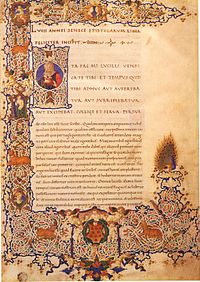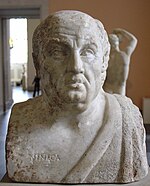
Lucius Annaeus Seneca the Younger, usually known mononymously as Seneca, was a Stoic philosopher of Ancient Rome, a statesman, dramatist, and in one work, satirist, from the post-Augustan age of Latin literature.
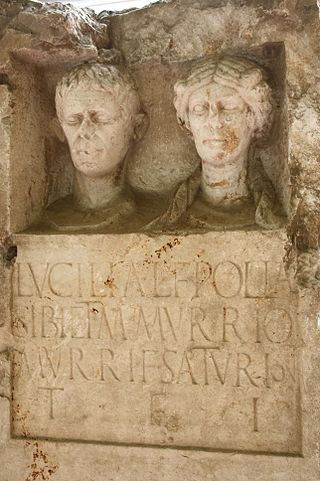
The gens Lucilia was a plebeian family at ancient Rome. The most famous member of this gens was the poet Gaius Lucilius, who flourished during the latter part of the second century BC. Although many Lucilii appear in Roman history, the only one known to have obtained any of the higher offices of the Roman state was Lucilius Longus, consul suffectus in AD 7.
Hecato or Hecaton of Rhodes was a Greek Stoic philosopher.

De Brevitate Vitae is a moral essay written by Seneca the Younger, a Roman Stoic philosopher, sometime around the year 49 AD, to his father-in-law Paulinus. The philosopher brings up many Stoic principles on the nature of time, namely that people waste much of it in meaningless pursuits. According to the essay, nature gives people enough time to do what is really important and the individual must allot it properly. In general, time is best used by living in the present moment in pursuit of the intentional, purposeful life.
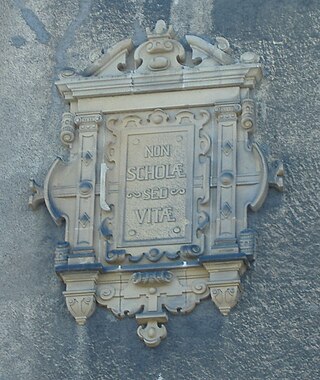
Non scholæ sed vitæ is a Latin phrase. Its longer form is non scholæ sed vitæ discimus, which means "We do not learn for school, but for life". The scholae and vitae are first-declension feminine datives of purpose.
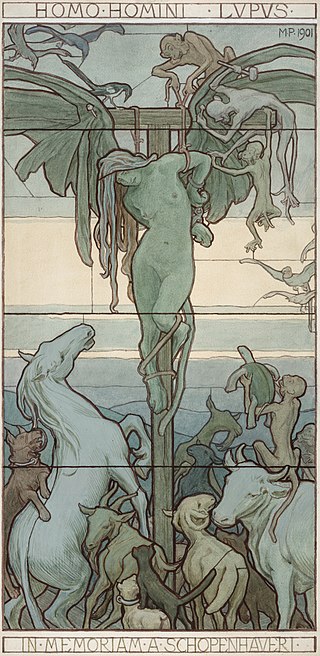
Homo homini lupus, or in its unabridged form Homo homini lupus est, is a Latin proverb meaning "Man is a wolf to man," or more literally "Man to man is wolf." It is used to refer to situations where a person has behaved comparably to a wolf. In this case, the wolf represents predatory, cruel, and generally inhuman qualities.
Epistulae or Epistles are a specific genre of letter-writing composed in Latin. The term may also refer to specific works:
Seneca's Consolations refers to Seneca’s three consolatory works, De Consolatione ad Marciam, De Consolatione ad Polybium, De Consolatione ad Helviam, written around 40–45 AD.

The gens Horatia was a patrician family at ancient Rome. In legend, the gens dates back to the time of Tullus Hostilius, the third King of Rome. One of its members, Marcus Horatius Pulvillus, was consul suffectus in 509 BC, the first year of the Republic, and again in 507. The most famous of the Horatii was his nephew, Publius Horatius Cocles, who held the Sublician bridge against the army of Lars Porsena circa 508 BC.
The gens Sextia was a plebeian family at ancient Rome, from the time of the early Republic and continuing into imperial times. The most famous member of the gens was Lucius Sextius Lateranus, who as tribune of the plebs from 376 to 367 BC, prevented the election of the annual magistrates, until the passage of the lex Licinia Sextia, otherwise known as the "Licinian Rogations," in the latter year. This law, brought forward by Sextius and his colleague, Gaius Licinius Calvus, opened the consulship to the plebeians, and in the following year Sextius was elected the first plebeian consul. Despite the antiquity of the family, only one other member obtained the consulship during the time of the Republic. Their name occurs more often in the consular fasti under the Empire.

De Clementia is a two volume (incomplete) hortatory essay written in AD 55–56 by Seneca the Younger, a Roman Stoic philosopher, to the emperor Nero in the first five years of his reign.

De Tranquillitate Animi is a Latin work by the Stoic philosopher Seneca. The dialogue concerns the state of mind of Seneca's friend Annaeus Serenus, and how to cure Serenus of anxiety, worry and disgust with life.

De Ira is a Latin work by Seneca. The work defines and explains anger within the context of Stoic philosophy, and offers therapeutic advice on what to do to prevent anger.

De Otio is a 1st-century Latin work by Seneca. It survives in a fragmentary state. The work concerns the rational use of spare time, whereby one can still actively aid humankind by engaging in wider questions about nature and the universe.
The gens Hateria, occasionally Ateria, was a plebeian family at ancient Rome, known from the last century of the Republic and under the early Empire. The most distinguished of the Haterii was Quintus Haterius, a senator and rhetorician in the time of Augustus and Tiberius. He was consul suffectus in 5 BC.
The gens Pacuvia was a minor plebeian family at ancient Rome. Members of this gens are first mentioned during the second century BC, and from then down to the first century of the Empire Pacuvii are occasionally encountered in the historians. The first of the Pacuvii to achieve prominence at Rome, and certainly the most illustrious of the family, was the tragic poet Marcus Pacuvius.
The gens Satellia was an obscure plebeian family of equestrian rank at ancient Rome. Few members of this gens are mentioned in ancient writers, but a number are known from inscriptions.
Negative visualization or futurorum malorum præmeditatio is a method of meditative praxis or askēsis by visualization of the worst-case scenario(s). The method originated with the Cyreanic philosophers and was later adopted by Stoic philosophers. The technique was made popular with publications of Seneca the Younger's Epistulae Morales ad Lucilium. It is thought to have been one of the common forms of Stoic spiritual exercises.
The gens Albinovana was an obscure plebeian family at ancient Rome. No members of this gens are known to have held any of the higher offices of the Roman state, and hardly any are mentioned in history. The family is perhaps best known from Publius Albinovanus, an infamous participant in the civil war between Marius and Sulla, and from the first-century poet Albinovanus Pedo. A number of Albinovani are known from inscriptions.
The gens Tanusia was an obscure plebeian family at ancient Rome. Few members of this gens are mentioned in history, and none attained any of the higher offices of the Roman state. Quintus Cicero mentions that the heads of this family were proscribed by Sulla, and Tanusius Geminus was a historian of the same period, whose work has now been lost. A few other Tanusii are known from epigraphy.
